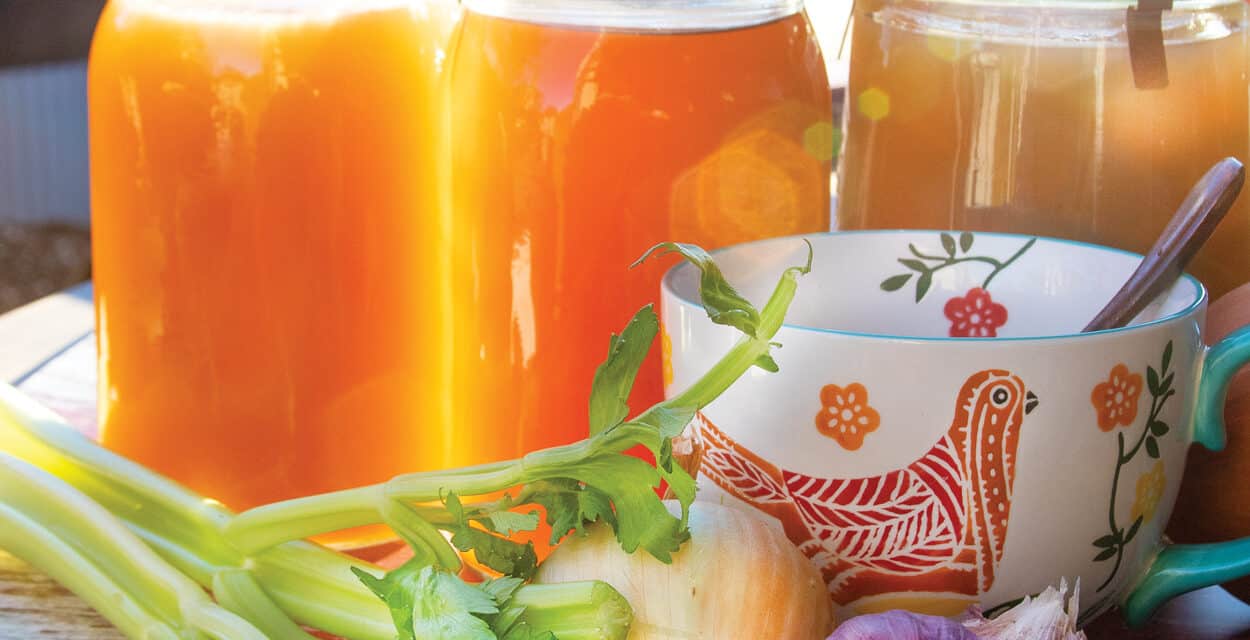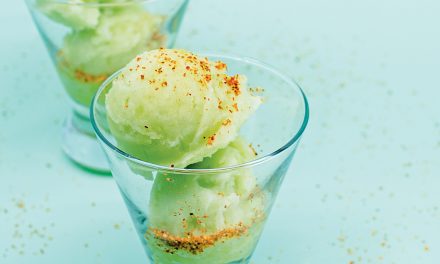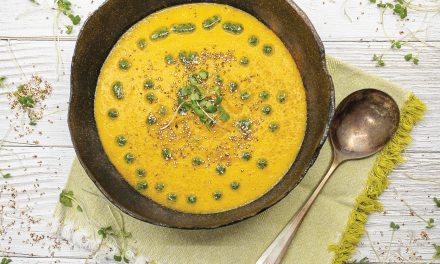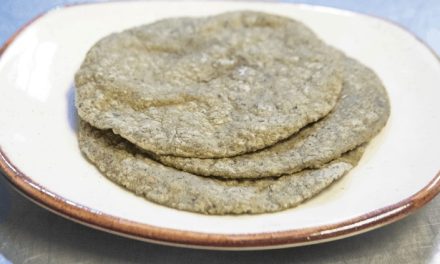
As the adage goes, all bourbons are whiskey, but not all whiskeys are bourbon. The same goes for broth and stock: all broths are stocks, but not all stocks are broths.
While there is no consensus on definitions, one way to consider the traditional difference between the two is to think of a stock as a building block and broth as a composite liquid served at the table. Generally speaking, stock is more viscous, due to the collagen that seeps out of joints and bones during long-term cooking, and a broth is thinner, due to using actual meat versus the meat-stripped bones used for stock. The confusion comes from current trends using “bone broth” as a term to describe what is essentially stock. Regardless of which you are making, homemade broths and stocks always taste better than store-bought versions. The two are often used interchangeably in food preparation; it is acceptable to substitute broth for stock in most recipes and vice versa. Yet, if you have a choice between the two, use broth when a dish is primarily based on the flavor of the liquid, such as in a broth-based soup. Use stock when the dish will get plenty of flavor from other ingredients, such as in a stew already using flavors from the drippings of a roast.
Marco Canora notes in his cookbook Brodo: A Bone Broth Cookbook that beef or lamb bone broth should take anywhere between sixteen and eighteen hours. For this reason, most would opt for a store-bought broth, but in this edition of Cooking Fresh, we are giving you a shortcut—enter the Instant Pot. With the recipes below, we include a much quicker way to get from point A to point B, but we also give you the longer, more traditional method. Try them both, have a taste test, and let us know if you prefer one over the other.
Once you have made your broth, try making Irish Stew with Lamb Bone Broth.
LAMB BONE BROTH
This lamb-and-herb bone broth can replace chicken, vegetable, or beef stock in your favorite recipes. Request lamb bones from your butcher, or buy a quarter lamb. You are sure to end up with enough extra lamb bones to make this recipe. A crucial step when making broth is to roast the bones first; this adds an immense depth of flavor.
LAMB BONE BROTH
Ingredients
- Lamb bones about 1 pound
- Lamb meat scraps about 1 cup
- 1 tablespoon olive oil
- 6 spring onions roughly chopped (or 1 large onion, quartered)
- 6 large carrots whole
- 6 1/2 cups water
- 4 stalks celery roughly chopped
- 4 sprigs rosemary
- 5 sprigs thyme
- Salt and pepper to taste
Instructions
INSTANT POT METHOD
- Preheat oven to 450°F. Place bones and carrots on a baking sheet and roast for 20–30 minutes, until browned.
- Meanwhile, set Instant Pot on sauté and add oil and lamb meat scraps. Cook for 2–3 minutes and turn off the sauté function.
- Place roasted bones and carrots in the Instant Pot with the meat scraps. Cover with 4 1/4 cups of water. Add celery, onion, and herbs; stir. Ensure liquid doesn’t go above the maximum fill line on your Instant Pot.
- Place lid on Instant Pot and set the valve to sealing; cook for 2 hours on high pressure. Manually release pressure when it beeps and allow it to cool for a few minutes so that it’s not too hot to handle. Strain broth into a wide, shallow container (see safety note).
- Place into a large jar, cover, and keep in the refrigerator overnight. The next day, skim the fat from the top of the broth and pour broth into containers for storing (see storage note).
STOVETOP METHOD
- Preheat oven to 450°F. Place bones and carrots on a baking sheet and roast for 20–30 minutes, until browned. Place roasted bones and all the solid ingredients into a large stockpot. Submerge in water so 2–4 inches of liquid is above ingredients, and ensure that there are a few inches between the top of the liquid and the top of the pot.
- Bring to a boil, skim the surface, and remove the fat pooling at the top every 20 minutes until it boils. Once it does, lower the heat. Simmer, covered, for at least 12 hours and up to 24. Check periodically and continue to add water to ensure the level does not drop below the top of the bones. Strain liquid and follow instructions above for storing.
Notes
Tip on seasoning: Don’t salt and pepper the liquid until you are ready to consume or use in a recipe. The amount of salt depends on whether you will be consuming the broth on its own or adding it to a recipe.
Vegetable Broth
Although making broth is a great way to use any vegetables, the broth benefits from fresh produce as well as frozen and wilted produce. If you know that veggies in your refrigerator might not get used before spoiling, give them a quick chop, throw them in a freezer bag, and save along with whatever vegetable odds and ends you produce every day. In a few weeks, you’ll have more than enough stuff to make a fair amount of stock, and it will keep for up to 6 months.
Roughly 4 cups of vegetables and scraps will produce about 8 cups of broth. The combination of onions, celery, carrots, and garlic in a typical commercial vegetable stock or broth is rather one-note—with homemade broth, there is no reason to limit yourself. Packing a variety of vegetables into a pot, whether an Instant Pot or traditional pot, and adding only enough water to cover the vegetables will result in a full-flavored broth.
Good vegetables for broth include carrots, celery, onions (any type), shallots, leeks, mushrooms (including stems), garlic, tomatoes, zucchini and other summer squash, asparagus, greens (spinach, chard, carrot tops), winter squash (in small amounts), and sweet potatoes.
Vegetables to avoid in broth are any in the brassica family (cabbage, cauliflower, brussels sprouts, mustard greens, turnips, rutabagas), and other strong-flavored vegetables.
Additional ingredients that will amp the flavor are fresh herbs such as parsley and bay leaves, kombu, dulse, nori, dried mushrooms, and canned tomatoes.
Roasting your ingredients for any broth creates a caramelization that adds adds umami to the flavor profile. Yes, it adds to the cooking time, but it is so worth it, and the Instant Pot makes up for the extra time spent.
Once you have created your broth, try making Lentil and Parsnip Soup with Umami Vegetable Broth.
UMAMI VEGETABLE BROTH
Ingredients
- 4 –5 carrots; cut large ones into pieces
- 2 –3 stalks celery cut into pieces
- 1 onion cut into chunks (skin and ends are fine)
- 1 bulb garlic cut in half crosswise
- 4 cups additional vegetables
- 8 cups water approximately
- 1/4- inch square kombu
- Handful mushroom bits
- Handful dried shiitake mushrooms
Instructions
INSTANT POT METHOD
- Preheat oven to 400°F. Arrange vegetables (except greens, kombu, and dried mushrooms) on a large baking sheet. Roast them until many of their edges brown, about 30 minutes. If using frozen and partially thawed vegetables, this will take additional time.
- Add roasted vegetables, kombu, dried mushrooms, and greens (if using) to the Instant Pot, pressing them down to keep them below the fill line. Fill the pot with water until level is even with the top of the vegetables (approximately 8 cups). Too much water means weak broth (and don’t salt the broth until you are ready to use it).
- Lock lid, and set for 30 minutes on high pressure. When cooking time has completed, turn off cook setting and allow pressure to release naturally for 10 minutes. Allow to cool for a few minutes so that it’s not too hot to handle. Strain the broth from the pot into a wide, shallow container (see safety note).
STOVETOP METHOD
- Follow the instructions above, adding vegetables and water to a large stockpot. Bring to a boil on high heat and then reduce to a simmer and cook uncovered for 1 hour.









